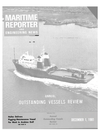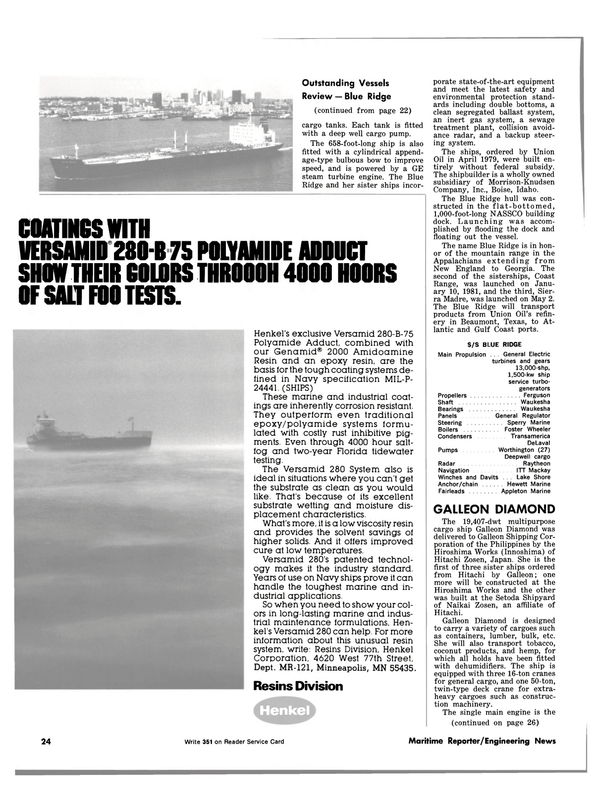
M/V Europa Completes Sea Trials; Luxury Cruise Liner Filled With Many Environmental Safeguards
The new flagship of the German merchant fleet, the luxury liner M / V Europa, recently completed almost three days of sea trials in the North Sea. The 35,000-grt liner is scheduled to undertake her maiden voyage on January 8, 1982.
The vessel was built by Bremer Vulkan shipyard, Bremen, West Germany, and was launched and christened on December 22, 1980.
The ship is owned by KG MS E u r o p a de B r e s c h a g , Bremer Schiffsvercharterungs-AG & Co.
KG, from which Hapag-Lloyd AG will be taking her on timecharters when she enters into service.
The Europa is powered by two Bremer Vulkan M.A.N. K7SZ 70 125 BL slow-speed reversible diesels, each with a maximum continuous output of 10,640 kw (2 by 14,460 hp) driving a fiveblade fixed-pitch propeller at a service speed of 21 knots. Cruising speed will normally be in the 14 to 18-knot range. The ship will accommodate 600 passengers and a crew of 275. Built to Germanischer Lloyd classification, the 656-foot-long cruise liner is the first newbuilding to be placed in passenger service by Hapag Lloyd since World War II.
The generating equipment comprises five diesel-driven generators which deliver a total 8,500 kw, plus two shaft generators driven by the main engines and designed to use surplus output while cruising. In addition, one emergency generator at 875 kva or 700 kw is supplied.
Besides the exhaust gas boilers linked with the main and auxiliary engines, the Europa is equipped with two oil-fired boilers each providing 12,500 kg/h of steam generation.
In addition to the luxurious surroundings, restaurants, and general ambiance, the design of the vessel i n c o r p o r a t e s many safety features. A double-skin c o n s t r u c t i o n was employed in housing the generating and propulsion machinery — including a separate watertight compartment f o r the former; modular construction was employed for the propulsion and generating machinery, switchgear, and steam generating plant, thus providing the required duplication; the engine room was fitted with a double carbon dioxide fire extinguisher system; the main fire bulkheads were built without air-conditioning vent breaks; and all passenger cabins were positioned above the bulkhead deck.
The Europa was subjected to extensive model testing for hydrodynamics and aerodynamics in order to optimize resistance, propulsion, behavior in heavy seas, maneuverability, propeller cavitation and oscillations, exhaust gas flow, and wind load. Equally exhaustive tests were made regarding static and dynamic behavior of the structural elements.
Noise, vibration, and ventilation tests were conducted with fullscale, mock-up cabins.
When the Europa was designed, special attention was paid to environmental protection, and as a result the ship satisfies all conceivable national and international requirements.
Wind tunnel tests were conducted so that passengers would not be exposed to exhaust gases on the open-air decks. This was achieved. The design and dimensions of the funnel keep away all exhaust gases.
Engine exhaust outlets: noise and dirt on open-air decks is minimized by c o m b i n i n g various sound-reduction units. Engine exhaust outlets have separate noisereducers.
There are a total of 11 exhaust outlets: two for the main engines, five for the diesel generators, one for the port emergency diesel, two for the auxiliary boilers, and one for the garbage incinerator.
Exhaust gas outlets from the garbage incinerator: soot and odors from this unit are also nonexistent on the open decks.
The garbage incinerator is fitted with nine parallel cyclones which separate ash on the gravity principle.
Three sewage treatment plants are provided for waste disposal.
The following installations are provided to prevent oil pollution: two sloptanks for the storage and interception of bilge water; two oil extraction units for the separation of bilge water. The deoiled water conforms to the latest IMCO regulations for coastal waters (oil residue of less than 15 ppm ; and water pumped overboard by the extraction units is continually monitored. If permitted levels are exceeded, the installations automatically stop the discharge of oil-polluted water.
Oil residues are burnt in the garbage incinerator.
Garbage is collected by means of a shaft running underneath all the accommodation decks.
Facilities are also available aboard the Europa for the disposal of noncombustible solid objects such as bottles and cans.
Read M/V Europa Completes Sea Trials; Luxury Cruise Liner Filled With Many Environmental Safeguards in Pdf, Flash or Html5 edition of December 1981 Maritime Reporter
Other stories from December 1981 issue
Content
- MarAd Approves Farrell Lines Ship Charter To Military Sealift Command page: 4
- 83 Vessel $3.4-Billion Program Planned By Japanese Shippers page: 4
- Veliotis Takes New Post With General Dynamics page: 4
- Petroterminal De Panama Selects EMH To Construct Tanker-Loading Buoys page: 6
- Name Peter West VP Of Transway Operations page: 6
- Sun Company, Levingston Sign Letter Of Intent For Pa. Shipyard Sale page: 6
- American Steamship Names D. Ward Fuller As Its Chief Operating Officer page: 6
- SNAME-Hampton Roads Hears Paper On Fuel Savings In Cargo Heating Systems page: 10
- Multipurpose Semisubmersible Built To Handle North Sea Emergencies page: 10
- Maher Expands Container Facility, To Install First Paceco Transtainers In N.Y. page: 15
- Kvaerner, Oy Navire To Merge Shipbuilding, Equipment Capabilities page: 15
- Baldt Inc. Develops New Abrasion-Resistant Chain —Brochure Available page: 15
- Kaiser Engineers Awarded Service Contract For Trident Sub Facilities page: 16
- SNAME Philadelphia Section Discusses Ship Design By Personal Computers page: 18
- M/V Europa Completes Sea Trials; Luxury Cruise Liner Filled With Many Environmental Safeguards page: 18
- Gulf Oil Announces Exec Assignments For Corporation And Divisions page: 18
- Award RCA $339 Million In Contracts For Navy's Aegis Weapon Systems page: 19
- Three Top Management Changes At Levingston page: 20
- Outstanding Vessels page: 22
- Largest U.S.-Built Hopper Dredge Launched At Avondale Shipyards page: 22
- ASNE Flagship Section Hears Paper On Engineering Costs And Risks page: 22
- DredgeMasters To Acquire Aquamarine Corporation page: 24
- Advanced Marine To Design New Ferryboat page: 24
- Newfoundland's Ocean Cargo Services Seen Expanding With Coming Offshore Oil Boom page: 24
- Soviets Plan Nuclear Powered Merchant Ship, To Be Completed By 1984 page: 25
- Spanish Shipbuilders Assoc. Publishes New Brochure —Copies Available page: 26
- Name John Malagraph General Manager Of Advanced Marine In N.Y. page: 26
- Shell To Provide Bunkering Service At Port Of Mobile —Literature Available page: 27
- Appoint Hession President Of Koehring Clyde, Whirley Crane Producer page: 27
- Name Parks President Of Farrell Lines page: 27
- Todd-Seattle Sponsors Marine Diesel Seminar page: 28
- Norcontrol To Install $3-Million Vessel Traffic System —Literature Available page: 28
- SNAME page: 36
- Moss Rosenberg Verft Develops Energy-Saving LNG Carrier page: 41
- $2.1-Million Title XI Guarantee For Tanker IGS And COW Retrofit page: 41
- SNAME New York Hears Paper On Marine Gas Chemists page: 42
- Utility Vessel M/V Lamnalco Mallard Delivered To Kuwait Service By HUDSHIP page: 42
- SNAME-New England, ASNE Hear Rear Adm. Beecher On Battleship Reactivation page: 42
- Allis-Chalmers Receives $6-Million M u d Pump Order From Wilson page: 43
- $1 -Billion Lube Oil Refinery To Be Constructed In Saudi Arabia page: 43
- Deliver 13th Supply Boat To Marsea Agencies Fleet, Plan Eight More For 1982 page: 48
- Paducah Marine Ways To Add Fab & Prop Shops page: 48
- Brown & Root Affiliate Awarded Pipeline Contract In Danish North Sea Area page: 50
- Maritime Safety Group Honors 12 Persons For Technical Presentations page: 50
- Award $12-Million Contract To Uniflite For Boats Used By Navy's Special Forces page: 53
- Hold Dedication And Ribbon-Cutting Ceremony At New Bell Halter Yard page: 53
- SNAME's Great Lakes And Rivers Section Meets At Universty Of Michigan page: 56
- Canadian Shipbuilders Group Sets Date For 1982 Conference page: 56
- Sperry Introduces New Ship Control System —Literature Available page: 57
- St. Louis Ship Announces Management Appointments At Engine Repair Division page: 58
- New Brochure Describes Allied Water/SweetWater R/O Water Maker page: 58
- Papers On Containerships, Bulkers Presented By SNAME California Sections page: 60
- Submarine LNG Carrier Proposed By General Dynamics For Arctic Regions page: 60
- Joseph Lykes To Retire As Head Of Lykes Steamship; James Amoss To Be CEO page: 69
- Student Papers Meeting Held By SNAME New England Section page: 69
- Coast Guard Proposes Maneuvering Standards For U.S.-Flag Vessels page: 70
- MSC Accepts Third Sea-Land Containership page: 70
- Commission Destroyer USS Scott Third Ship In A New Class page: 81
- Nuclear Attack Submarine La Jolla Commissioned At New London page: 81
- Bergeron Delivers 160-Foot Tank Barge Tide Mar 34 To Tidewater Marine page: 87
- Kings Craft Delivers Matmar Drill III, Third Of Four Crewboats From Yard page: 87


